PHP和MySQL Web开发(原书第3版)中文版PDF
PHPMYSQL动态网站开发电子课件-最全资料PPT
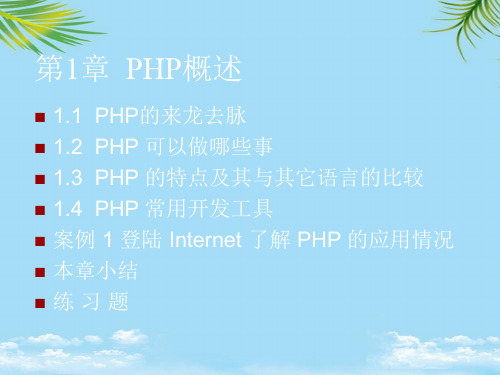
10
1.4 PHP 常用开发工具
3. PHPEdit
2021年6月23日星期三
本书技术支持站点:
11
1.4 PHP 常用开发工具
4. Zend Studio
简单阐述:优秀的IDE, 各个功能丰富,Zend的拳头产品,带有CVS 集成,项目管理也较为丰富,但作为商业软件,价格颇高,一般个人 用户没有太大必要去购买。
2.1 什么是HTML
HTML只是一个纯文本文件。创建一个HTML文档, 只 需 要 两 个 工 具 , 一 个 是 HTML 编 辑 器 , 一 个 WEB浏览器。
HTML编辑器是用于生成和保存HTML文档的应用 程序,如记事本、写字板。WEB浏览器是用来打 开WEB网页文件,提供给我们查看WEB资源的客 户端程序,如Internet Explorer,Netscape等。
14
1.4 PHP 常用开发工具
1. UltraEdit
简单阐述:这款功能强大的文本编辑器,可以编辑文字、Hex、 ASCII码,可以取代记事本,可同时编辑多个文件,而且即使开启很 大的文件速度也不会慢。最新版本的软件修正了老版本存在的一些 Bug,并新增了二十余项新功能。
2021年6月23日星期三
2.1 什么是HTML
输入代码完毕保存文件的时候,应当注意几 点:
2、保存类型,一定选择所有文件,否则会默认保存为文本文档 (后缀.txt)。
当我们保存完毕之后,就会看到目录下多了 这样一个文件, 这就说明我们把文件正确保存了,双击用默认的Internet Explorer 打开。
2.1 什么是HTML
其他脚本语言的不同在于,PHP能够诞生并且发展到今天的规模,
可以说是全世界各位免费代码开发者共同努力的结果。它是通过
php和mysql web开发

php和mysql web开发绝密文件,核心资料,拒绝盗版,支持正版,从我做起,一切是在为了方便大家~知识就是力量~一、英文原文Laura Thomson .php and mysql web developLuke Welling,Laura ThomsonPHP is a scripting language originally designed for producing dynamic web pages. It has evolved to include a command line interface capability and can be used in standalone graphical applications.While PHP was originally created by Rasmus Lerdorf in 1995, the main implementation of PHP is now produced by The PHP Group and serves as the de facto standard for PHP as there is no formal specification. PHP is free software released under the PHP License, however it is incompatible with the GNU General Public License (GPL), due to restrictions on the usage of the term PHP.PHP is a widely-used general-purpose scripting language that is especially suited for web development and can be embedded into HTML. It generally runs on a web server, taking PHP code as its input and creating web pages as output. It can be million websites and 1 million web servers.PHP originally stood for Personal Home Page. It began in 1994 as a set of Common Gateway Interface binaries written in the C programming language by the Danish/Greenlandic programmer Rasmus Lerdorf. Lerdorf initially created these Personal Home Page Tools to replace a small set of Perl scripts he had been using to maintain his personal homepage. The tools were used to perform tasks such as displaying his résumé and recording how much traffic his page was receiving. He combined these binaries with his Form Interpreter to create PHP/FI, which had more functionality. PHP/FI included a larger implementation for the C programming language and could communicate with databases, enabling the building of simple, dynamic web applications. Lerdorf released PHP publicly on June 8, 1995 to accelerate bug location and improve the code.This release was named PHP version 2 and already had the basicfunctionality that PHP has today. This included Perl-like variables,form handling, and the ability to embed HTML. The syntax was similar to Perl but was more limited, simpler, and less consistent.Zeev Suraski and Andi Gutmans, two Israeli developers at theTechnion IIT, rewrote the parser in 1997 and formed the base of PHP 3, changing the language's name to the recursive initialism PHP: Hypertext Preprocessor. The development team officially released PHP/FI 2 in November 1997 after months of beta testing. Afterwards, public testingof PHP 3 began, and the official launch came in June 1998. Suraski and Gutmans then started a new rewrite of PHP's core, producing the Zend Engine in 1999. They also founded Zend Technologies in Ramat Gan, Israel. On May 22, 2000, PHP 4, powered by the Zend Engine 1.0, was released. On July 13, 2004, PHP 5 was released, powered by the new Zend Engine II. PHP 5 included new features such as improved support for object-oriented programming, the PHP Data Objects extension (which defines a lightweight and consistent interface for accessing databases), and numerous performance enhancements. The most recent update released by The PHP Group is for the older PHP version 4 code branch. As of August, 2008this branch is up to version 4.4.9. PHP 4 is no longer under development nor will any security updates be released.In 2008, PHP 5 became the only stable version under development.Late static binding has been missing from PHP and will be added in version 5.3. PHP 6 is underdevelopment alongside PHP 5. Major changes include the removal of register_globals, magic quotes, and safe mode. The reason for the removals was because register_globals had given way to security holes, and magic quotes had an unpredictable nature, and was best avoided. Instead, to escape characters, magic quotes may be substituted with the addslashes() function, or more appropriately an escape mechanism specific to the database vendor itself likemysql_real_escape_string() for MySQL.PHP does not have complete native support for Unicode or multibyte strings; Unicode support will be included in PHP 6. Many high profile open source projects ceased to support PHP 4 in new code as of February 5, 2008, due to the GoPHP5 initiative, provided by a consortium of PHP developers promoting the transition from PHP 4 to PHP 1397 It runs in both 32-bit and 64-bit environments, but on Windows the only official distribution is 32-bit, requiring Windows 32-bit compatibility mode to be enabled while using IIS in a 64-bit Windows environment. There is a third-party distribution available for 64-bit Windows.PHP is a general-purpose scripting language that is especially suited for web development. PHP generally runs on a web server, taking PHP code as its input and creating web pages as output. It can also be used for command-line scripting and client-side GUI applications. PHP can be deployed on most web servers, many operating systems and platforms, and can be used with many relational database management systems. It is available free of charge, and the PHP Group provides thecomplete source code for users to build, customize and extend for their own use. PHP primarily acts as a filter, taking input from a file or stream containing text and/or PHP instructions and outputs another stream of data; most commonly the output will be HTML. It can automatically detect the language of the user. From PHP 4, the PHP parser compiles input to produce bytecode for processing by the Zend Engine, giving improved performance over its interpreter predecessor.Originally designed to create dynamic web pages, PHP's principal focus is server-side scripting, and it is similar to other server-side scripting languages that provide dynamic content from a web server to a client, such as Microsoft's Active Server Pages, Sun Microsystems' JavaServer Pages, and mod_perl. PHP has also attracted the development of many frameworks that provide building blocks and a design structure to promote rapid application development (RAD). Some of these include CakePHP, Symfony, CodeIgniter, and Zend Framework, offering features similar to other web application frameworks.The LAMP architecture has become popular in the web industry as a way of deploying web applications. PHP is commonly used as the P in this bundle alongside Linux, Apache and MySQL, although the P may also refer to Python or Perl.As of April 2007, over 20 million Internet domains were hosted on servers with PHP installed, and PHP was recorded as the most popular Apache module. Significant websites are written in PHP including the user-facing portion of Facebook, Wikipedia , PHP can be used to createstand-alone, compiled applications and libraries, it can be used forshell scripting, and the PHP binaries can be called from the command line.As with many scripting languages, PHP scripts are normally kept as human-readable source code, even on production web servers. In this case, PHP scripts will be compiled at runtime by the PHP engine, which increases their execution time. PHP scripts are able to be compiled before runtime using PHP compilers as with other programming languages such as C (the language PHP and its extensions are written in).Code optimizers aim to reduce the computational complexity of the compiled code by reducing its size and making other changes that can reduce the execution time with the overall goal of improving performance. The nature of the PHP compiler is such that there are oftenopportunities for code optimization, and an example of a code optimizer is the Zend Optimizer PHP extension.Another approach for reducing overhead for high load PHP servers is using PHP accelerators. These can offer significant performance gains by caching the compiled form of a PHP script in shared memory to avoid the overhead of parsing and compiling the code every time the script runs.The National Vulnerability Database stores all vulnerabilities found in computer software. The overall proportion of PHP-relatedvulnerabilities on the database amounted to: 12% in 2003, 20% in 2004, 28% in 2005, 43% in 2006, 36% in 2007, and 35% in 2008. Most of these PHP-related vulnerabilities can be exploited remotely: they allowhackers to steal or destroy data from data sources linked to the webserver (such as an SQL database), send spam or contribute to DOS attacks using malware, which itself can be installed on the vulnerable servers.These vulnerabilities are caused mostly by not following best practice programming rules: technical security flaws of the language itself or of its core libraries are not frequent. Recognizing that programmers cannot be trusted, some languages include taint checking to detect automatically the lack of input validation which induces many issues. Such a feature is being developed for PHP. Although it may be included in mainstream PHP in a future release, its inclusion has been rejected several times in the past.Hosting PHP applications on a server requires a careful and constant attention to deal with these security risks. There are advanced protection patches such as Suhosin and Hardening-Patch, especially designed for web hosting environments. Installing PHP as a CGI binary rather than as an Apache module is the preferred method for added security.With respect to securing the code itself, PHP code can be obfuscated to make it difficult to read while remaining functional.Syntax-highlighted PHP code embedded within HTMLPHP only parses code within its delimiters. Anything outside its delimiters is sent directly to the output and is not parsed by PHP. The most common delimiters are <?php and ?>, which are open and close delimiters respectively. <scriptlanguage="php"> and </script> delimiters are also available. Short tags can be used to start PHP code, <? or <?= (which is used to echo back a string or variable) and the tag to end PHP code, ?>. These tags are commonly used, but like ASP-style tags (<% or <%= and %>), they are less portable as they can be disabled in the PHP configuration. For this reason, the use of short tags and ASP-style tags is discouraged. The purpose of these delimiters is to separate PHPcode from non-PHP code, including HTML.Variables are prefixed with a dollar symbol and a type does not need to be specified in advance. Unlike function and class names, variable names are case sensitive. Both double-quoted ("") and heredoc strings allow the ability to embed a variable's value into the string. PHPtreats newlines as whitespace in the manner of a free-form language (except when inside string quotes), and statements are terminated by a semicolon. PHP has three types of comment syntax: /* */ serves as block comments, and // as well as # are used for inline comments. The echo statement is one of several facilities PHP provides to output text (e.g. to a web browser).In terms of keywords and language syntax, PHP is similar to mosthigh level languages that follow the C style syntax. If conditions, for and while loops, and function returns are similar in syntax to languages such as C, C++, Java and Perl.PHP stores whole numbers in a platform-dependent range. This rangeis typically that of 32-bit signed integers. Unsigned integers areconverted values in certain situations; this behavior is different from other programming languages.Integer variables can be assigned using decimal (positive and negative), octal, and hexadecimal notations. Floating point numbers are also stored in a platform-specific range. They can be specified using floating point notation, or two forms of scientific notation. PHP has a native Boolean type that is similar tothe native Boolean types in Java and C++. Using the Boolean type conversion rules, non-zero values are interpreted as true and zero as false, as in Perl and C++.The null data type represents a variable that has no value. The only value in the null data type is NULL. Variables of the "resource" type represent references to resources from external sources. These are typically created by functions from a particular extension, and can only be processed by functions from the same extension; examples include file, image, and database resources. Arrays can contain elements of any type that PHP can handle, including resources, objects, and even other arrays. Order is preserved in listsof values and in hashes with both keys and values, and the two can be intermingled. PHP also supports strings, which can be used with single quotes, double quotes, or heredoc syntax.The Standard PHP Library (SPL) attempts to solve standard problems and implements efficient data access interfaces and classes.PHP has hundreds of base functions and thousands more via extensions. These functions are well documented on the PHP site, but unfortunately,the built-in library has a wide variety of naming conventions and inconsistencies. PHP currently has no functions for thread programming.Functions are not first-class functions and can only be referencedby their name--directly or dynamically by a variable containing the name of the function. User-defined functions can be created at any time without being prototyped. Functions can be defined inside code blocks, permitting a run-time decision as to whether or not a function should be defined. Function calls must use parentheses, with the exception of zero argument class constructor functions called with the PHP new operator, where parentheses are optional. PHP supports quasi-anonymous functions through the create_function() function, although they are not true anonymous functions because anonymous functions are nameless, but functions can only bereferenced by name, or indirectly through a variable$function_name();, in PHP.PHP gained support for first-class functions and closures. True anonymous functions are supported using the following syntax: function getAdder($x){return function ($y) use ($x) {return $x + $y;};}$adder = getAdder(8);echo $adder(2); // prints "10"Here, getAdder() function creates a closure using parameter $x (keyword "use" forces getting variable from context), which, etc. For more details see Lambda functions and closures RFC.Basic object-oriented programming functionality was added in PHP 3 and improved in PHP 4.[3] Object handling was completely rewritten for PHP 5, expanding the feature set and enhancing performance. In previous versions of PHP, objects were handled like primitive types. The drawback of this method was that the whole object was copied when a variable was assigned or passed as a parameter to a method. In the new approach, objects are referenced by handle, and not by value. PHP 5 introduced private and protected member variables and methods, along with abstract classes and final classes as well as abstract methods and final methods. It also introduced a standard way of declaring constructors and destructors, similar to that of other object-oriented languages such as C++, and a standard exception handling model. Furthermore, PHP 5 added interfaces and allowed for multiple interfaces to be implemented. There are special interfaces that allow objects to interact with the runtime system. Objects implementing ArrayAccess can be used with array syntax and objects implementing Iterator or IteratorAggregate can be used with the foreach language construct. There is no virtual table feature in the engine, so static variables are bound with a name instead of a reference at compile time.If the developer creates a copy of an object using the reserved word clone, the Zend engine will check if a __clone() method has been defined or not. If not, it will call a default __clone() which will copy the object's properties. If a __clone() method is defined, then it will be responsible for setting the necessary properties in the created object. For convenience, the engine will supply a function that imports the properties of the source object, so that the programmer can start witha by-value replica of the source object and only override properties that need to be changed.PHP includes free and open source libraries with the core build. PHP is a fundamentally Internet-aware system with modules built in for accessing FTP servers, many database servers, embedded SQL libraries such as embedded PostgreSQL, MySQL and SQLite, LDAP servers, and others. Many functions familiar to C programmers such as those in the stdio family are available in the standard PHP build. PHP has traditionally used features such as "magic_quotes_gpc" and"magic_quotes_runtime" which attempt to escape apostrophes (') and quotes (") in strings in the assumption that they will be used in databases, to prevent SQL injection attacks. This leads to confusion over which data is escaped and which is not, and to problems when data is not in fact used as input to a database and when the escaping used is not completely correct.[68] To make code portable between servers which do and do not use magic quotes, developers can preface their code with a script to reverse the effect of magic quotes when it is applied.PHP allows developers to write extensions in C to add functionalityto the PHP language. These can then be compiled into PHP or loaded dynamically at runtime. Extensions have been written to add support for the Windows API, process management on Unix-like operating systems, multibyte strings (Unicode), cURL, and several popular compression formats. Some more unusual features include integration with Internet Relay Chat, dynamic generation of images and Adobe Flash content, and even speech synthesis. The PHP Extension Community Library (PECL)project is a repository for extensions to the PHP language.Zend providesa certification exam for programmers to become certified PHP developers.二、英文翻译php和mysql web开发PHP是一种脚本语言,最初用于生产动态网页设计。
PHP和MySQLWeb开发

目录
• PHP基础 • MySQL基础 • PHP与MySQL的连接 • PHP Web开发 • 实例:简易博客系统 • 安全性和优化
01
PHP基础
PHP简介
1
PHP是一种通用的开源脚本语言,主要用于Web 开发,也可用于开发命令行脚本和桌面应用程序。
2
PHP最初设计用于创建动态交互的Web页面,自 1995年诞生以来,PHP已成为最流行的Web开 发语言之一。
使用适当的凭据(如主机名、用 户名、密码和数据库名)创建与 MySQL数据库的连接。
根据需要设置连接参数,如数据 库字符集、连接超时时间等。
查询MySQL数据库
构建查询语句
使用适当的SQL查询语句,根据需要选择、 插入、更新或删除数据。
执行查询
通过数据库连接执行查询语句,并获取结果 集。
处理结果
对结果集进行处理,如遍历结果集、提取数 据等。
插入、更新和删除MySQL数据
插入数据
构建插入语句,将新数据插入到MySQL数 据库中。
更新数据
构建更新语句,根据条件更新MySQL数据 库中的现有数据。
删除数据
构建删除语句,从MySQL数据库中删除记 录。
04
PHP Web开发
HTML与PHP的结合
HTML用于构建网页结构,而PHP用于处理逻辑和动态内 容。
02
MySQL基础
MySQL简介
数据库管理系统
MySQL是一个流行的关系型数据库管理系 统,用于存储和管理大量结构化数据。
跨平台性
MySQL可以在多种操作系统上运行,包括 Windows、Linux和Mac OS。
性能与可扩展性
PHP和MySQL_Web开发
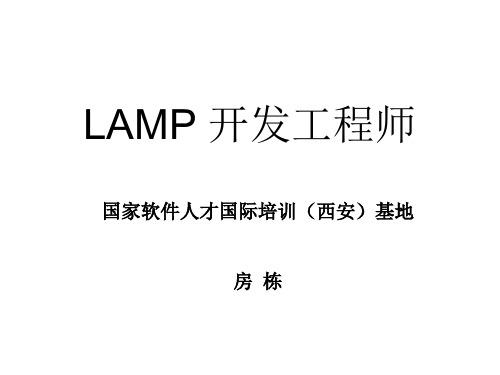
软件的分类
软件按使用方式来分 商业软件:Windows、Office、SQLServer 共享软件:WinRAR、优化大师、…. 开源软件:Linux、OpenOffice….
软件的生存周期
阶段 软件计划 基本任务 明确工作范围 工作结果 计划任务书
需求分析
软件设计 程序编码 系统测试 系统维护
定义用户要求
编写程序代码
需求规格书
建立软件逻辑结构 设计说明书 程序清单 尽可能发现多的错 可运行系统,测试报告 误 运行和改进 改进的系统
软件项目开发工作流程
软件计划
需求分析 计划任务书 需求规格书
软件设计
软件编码 设计说明书 程序清单
软件测试
功能,性能 及系统 环境变 化
测试报告
软件维护
软件项目开发工作流程(瀑布模型)
含的文本只出现在网络浏览器的标题栏上,而不在网 页上出现。 <body>标识符表明了HTML文件的主体部分,所有需 要在浏览器上显示的文本及标识符都应该被放置在 这里。例如,HelloWorld!被放置在此。因为想让 这句话在网页上显示出来,网页的所有内容几乎都 由<body>及</body>标识符包含。 <!-- 要注释的内容 -->表示注释,它并不在主页上 显示出来。注释,这种只是针对HTML标识符的注 释,并不能注释PHP的语句。大家在以后写程序的 时候尽量对程序中的语句加上注释,便于日后查看。
简单高效。和Java、Perl、C++等程序设计语言 不同,PHP坚持以基本语言为基础,但同时它的 功能又能够强大到足以支持任何类型的Web站点。
构架PHP开发平台
目前大多数支持PHP的网站都采用 Linux/Windows作为操作系统,Apache作为 Web服务器,Mysql作为数据库(LAMP)的 方案。Linux和Apache都是功能强大的免费软 件,对硬件要求不高,是中小型网站的理想平 台。 所需软件: (1)PHP源程序C语言代码。 (2)MySQL源程序 (3)Apache 源程序
基于PHP与FPDF的PDF文档的动态创建
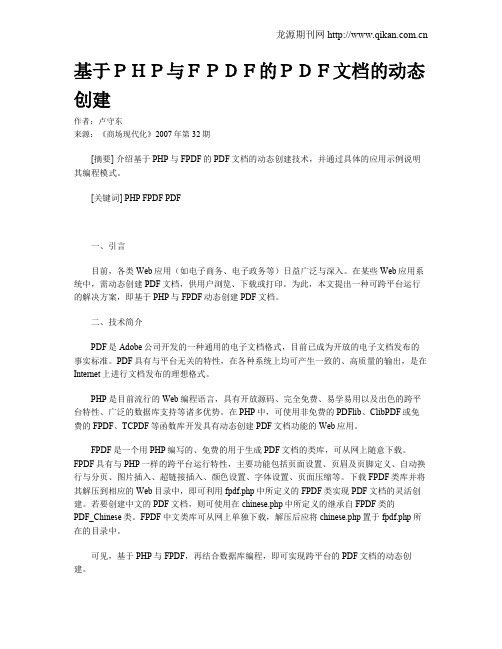
基于PHP与FPDF的PDF文档的动态创建作者:卢守东来源:《商场现代化》2007年第32期[摘要] 介绍基于PHP与FPDF的PDF文档的动态创建技术,并通过具体的应用示例说明其编程模式。
[关键词] PHP FPDF PDF一、引言目前,各类Web应用(如电子商务、电子政务等)日益广泛与深入。
在某些Web应用系统中,需动态创建PDF文档,供用户浏览、下载或打印。
为此,本文提出一种可跨平台运行的解决方案,即基于PHP与FPDF动态创建PDF文档。
二、技术简介PDF是Adobe公司开发的一种通用的电子文档格式,目前已成为开放的电子文档发布的事实标准。
PDF具有与平台无关的特性,在各种系统上均可产生一致的、高质量的输出,是在Internet上进行文档发布的理想格式。
PHP是目前流行的Web编程语言,具有开放源码、完全免费、易学易用以及出色的跨平台特性、广泛的数据库支持等诸多优势。
在PHP中,可使用非免费的PDFlib、ClibPDF或免费的FPDF、TCPDF等函数库开发具有动态创建PDF文档功能的Web应用。
FPDF是一个用PHP编写的、免费的用于生成PDF文档的类库,可从网上随意下载。
FPDF具有与PHP一样的跨平台运行特性,主要功能包括页面设置、页眉及页脚定义、自动换行与分页、图片插入、超链接插入、颜色设置、字体设置、页面压缩等。
下载FPDF类库并将其解压到相应的Web目录中,即可利用fpdf.php中所定义的FPDF类实现PDF文档的灵活创建。
若要创建中文的PDF文档,则可使用在chinese.php中所定义的继承自FPDF类的PDF_Chinese类。
FPDF中文类库可从网上单独下载,解压后应将chinese.php置于fpdf.php所在的目录中。
可见,基于PHP与FPDF,再结合数据库编程,即可实现跨平台的PDF文档的动态创建。
三、基本步骤使用FPDF创建PDF文档的基本步骤为:1.利用FPDF类或PDF_Chinese类创建英文或中文的PDF文档对象实例。
第3章 MySQL数据库基础.pdf_PHP 开发典型模块大全(第3版)_[共25页]
![第3章 MySQL数据库基础.pdf_PHP 开发典型模块大全(第3版)_[共25页]](https://img.taocdn.com/s3/m/34a13b2dfab069dc512201a3.png)
MySQL 数据库基础PHP 支持多种数据库平台,只有与MySQL 数据库相结合,才能发挥动态网页编程语言的魅力。
本章通过phpMyAdmin 图形化管理工具详细介绍MySQL 数据库的基础知识,读者不但可以轻松掌握操作MySQL 数据库、数据表的方法,也可以学会对MySQL 数据进行查询、操作的技术。
通过本章的学习,读者能够学到以下内容。
启动、连接、断开、关闭MySQL 服务器。
MySQL 数据库的备份和恢复。
Windows 下PHPMyAdmin 的安装和配置。
Linux 下PHPMyAdmin 的安装和配置。
操作MySQL 数据库技术。
操作MySQL 数据表技术。
操作MySQL 语句的技术。
管理数据记录。
生成MySQL 数据库脚本。
执行MySQL 数据库脚本。
第3章PHP开发典型模块大全(第3版)583.1 MySQL数据库3.1.1 MySQL简介MySQL是目前最为流行的开放源码的数据库,是完全网络化的跨平台的关系型数据库系统,由瑞典的MySQL AB公司开发、发布并支持,由MySQL的初始开发人员David Axmark 和Michael Monty Widenius于1995年建立。
它的象征符号是一只名为Sakila的海豚,代表着MySQL数据库和社团的速度、能力、精确和优秀本质。
目前MySQL被广泛地应用在Internet上的中小型网站中。
由于其体积小、速度快、总体拥有成本低,尤其是开放源码这一特点,很多公司向开放源码的数据库管理系统迁移,从而降低花费成本,深受广大用户青睐。
3.1.2 MySQL的特点MySQL具有以下主要特点。
功能强大:MySQL中提供了多种数据库存储引擎,各引擎各有所长,适用于不同的应用场合,用户可以选择最合适的引擎以得到最高性能,可以处理每天访问量超过数亿的高强度的搜索Web站点。
MySQL 5支持事务、视图、存储过程、触发器等。
支持跨平台:MySQL支持至少20种以上的开发平台,包括Linux、Windows、FreeBSD、IBMAIX、AIX、FreeBSD等。
PHP+MySQL Web应用开发
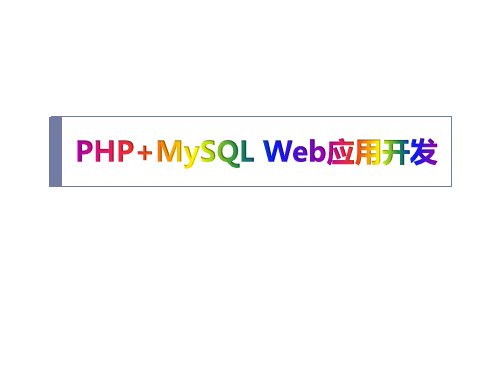
4. 管理ApacheБайду номын сангаас务
Apache服务器主程序httpd.exe;Apache HTTP Server Monitor实用工具;Windows服务管理工具。
5. 测试Apache服务
http://localhost
6. 设置Apache服务器主目录
4. 测试PHP
新建PHP文件并输入以下内容: <?php phpinfo(); ?>
1.2 PHP开发环境分立组件安装
1.2.3 下载和配置MySQL(1)
1. 下载和解压MySQL
MySQL社区版下载网址: https:// /downloads/mysql/
一直是互联网上最受欢迎的Web服务器软件 它快速、可靠且易于扩展,具有卓越的跨平台性和安全性 几乎可以运行在所有广泛使用的计算机平台上,目前占据了Web服务器
60%以上的份额。
Apache的主要特点。 Apache是网站Web服务器软件的最佳选择。
1.1 PHP开发组件介绍
1.1.2 PHP语言 PHP(PHP:Hypertext Preprocessor)
1.2.3 下载和配置MySQL(2) 3. 安装MySQL服务器
MySQL服务器初始化:mysqld --initialize --console 注册MySQL服务:mysqld install 启动MySQL服务: net start mysql
4. 登录MySQL服务器
mysql -uroot -p
5. 管理MySQL服务
命令方式:使用MySQL服务器程序mysqld.exe或网络命令net对MySQL服务 进行管理。
2008级毕业设计(论文)开题报告
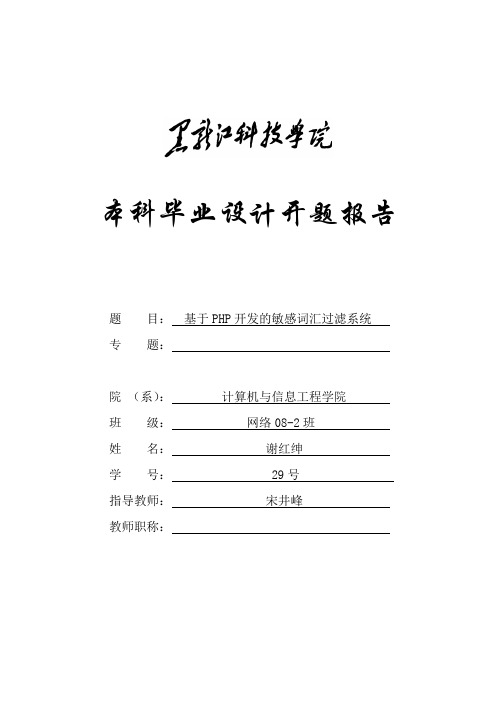
本科毕业设计开题报告题目:基于PHP开发的敏感词汇过滤系统专题:院(系):计算机与信息工程学院班级:网络08-2班姓名:谢红绅学号: 29号指导教师:宋井峰教师职称:黑龙江科技学院本科毕业设计开题报告题目基于PHP开发的敏感词汇过滤系统来源自拟题目1、研究目的和意义随着计算机信息技术的飞速发展,互联网与人类社会的工作、生活越来越紧密相关,互联网已经称为人类获取信息、交流信息的重要手段。
互联网为人们提供了一种全新的信息交流方式和人际交往方式,其无限性、虚拟性、自由性打破了传统的社会生活模式。
而互联网也面对着各种垃圾信息、反动言论、色情内容泛滥的趋势,而处理这些不良信息花费网站管理员大量的时间与精力,给网站的正常使用带来了诸多麻烦。
对于互联网企业来说,不良信息会给企业造成巨大的经济损失和负面影响。
目前互联网上大多数网站均采用了各种各样的技术来过滤不良信息,而其中一些网站面临着敏感词检测性能低下、识别率低、可移植性差等诸多问题。
我所做的课题基于PHP开发的敏感词汇过滤系统,采用流行的MVC结构,C/C++扩展接口检测算法基于字典树算法,效率跟字典的大小无关,所以即使敏感词字典库多大,都能够快速的进行敏感词检测过滤。
针对目前敏感词汇过滤的现状,设计一个高效、稳定、可移植的敏感词汇过滤系统。
通过优化设计,提高运行效率,降低互联网企业运营成本,避免不必要的经济损失和企业负面影响。
2、国内外发展情况(文献综述)现在国内外也有很多敏感词汇过滤系统,采用的技术也是多种多样,例如基于C/C++、JSP、PHP、C#、ASP等,大多数敏感词汇过滤系统都是采用单一语言实现,但是网站使用的往往是综合各种语言技术,以求达到最优设计。
所以,这类敏感词汇过滤系统的性能、灵活性、敏捷开发总是存在一些问题,而国外的敏感词过滤系统多应用在邮件服务器中,不便于移植。
针对互联网网站的实际需求,设计一个高性能、易架设、操作简便、便于安装的敏感词汇过滤系统,帮助互联网企业提升用户体验。
php和mysql web开发

一、英文原文Laura Thomson .php and mysql web developLuke Welling,Laura Thomson PHP is a scripting language originally designed for producing dynamic web pages. It has evolved to include a command line interface capability and can be used in standalone graphical applications.While PHP was originally created by Rasmus Lerdorf in 1995, the main implementation of PHP is now produced by The PHP Group and serves as the de facto standard for PHP as there is no formal specification. PHP is free software released under the PHP License, however it is incompatible with the GNU General Public License (GPL), due to restrictions on the usage of the term PHP.PHP is a widely-used general-purpose scripting language that is especially suited for web development and can be embedded into HTML. It generally runs on a web server, taking PHP code as its input and creating web pages as output. It can be million websites and 1 million web servers.PHP originally stood for Personal Home Page. It began in 1994 as a set of Common Gateway Interface binaries written in the C programming language by the Danish/Greenlandic programmer Rasmus Lerdorf. Lerdorf initially created these Personal Home Page Tools to replace a small set of Perl scripts he had been using to maintain his personal homepage. The tools were used to perform tasks such as displaying his résuméand recording how much traffic his page was receiving. He combined these binaries with his Form Interpreter to create PHP/FI, which had more functionality. PHP/FI included a larger implementation for the C programming language and could communicate with databases, enabling the building of simple, dynamic web applications. Lerdorf released PHP publicly on June 8, 1995 to accelerate bug location and improve the code.This release was named PHP version 2 and already had the basic functionality that PHP has today. This included Perl-like variables, form handling, and the ability to embed HTML. The syntax was similar to Perl but was more limited, simpler, and less consistent.Zeev Suraski and Andi Gutmans, two Israeli developers at the Technion IIT, rewrote the parser in 1997 and formed the base of PHP 3, changing the language's name to the recursive initialism PHP: Hypertext Preprocessor. The development team officially released PHP/FI 2 in November 1997 after months of beta testing. Afterwards, public testing of PHP 3 began, and the official launch came in June 1998. Suraski and Gutmans then started a new rewrite of PHP's core, producing the Zend Engine in 1999. They also founded Zend Technologies in Ramat Gan, Israel.On May 22, 2000, PHP 4, powered by the Zend Engine 1.0, was released. On July 13, 2004, PHP 5 was released, powered by the new Zend Engine II. PHP 5 included new features such as improved support for object-oriented programming, the PHP DataObjects extension (which defines a lightweight and consistent interface for accessing databases), and numerous performance enhancements. The most recent update released by The PHP Group is for the older PHP version 4 code branch. As of August, 2008 this branch is up to version 4.4.9. PHP 4 is no longer under development nor will any security updates be released.In 2008, PHP 5 became the only stable version under development. Late static binding has been missing from PHP and will be added in version 5.3. PHP 6 is under development alongside PHP 5. Major changes include the removal of register_globals, magic quotes, and safe mode. The reason for the removals was because register_globals had given way to security holes, and magic quotes had an unpredictable nature, and was best avoided. Instead, to escape characters, magic quotes may be substituted with the addslashes() function, or more appropriately an escape mechanism specific to the database vendor itself like mysql_real_escape_string() for MySQL.PHP does not have complete native support for Unicode or multibyte strings; Unicode support will be included in PHP 6. Many high profile open source projects ceased to support PHP 4 in new code as of February 5, 2008, due to the GoPHP5 initiative, provided by a consortium of PHP developers promoting the transition from PHP 4 to PHP 1397 It runs in both 32-bit and 64-bit environments, but on Windows the only official distribution is 32-bit, requiring Windows 32-bit compatibility mode to be enabled while using IIS in a 64-bit Windows environment. There is a third-party distribution available for 64-bit Windows.PHP is a general-purpose scripting language that is especially suited for web development. PHP generally runs on a web server, taking PHP code as its input and creating web pages as output. It can also be used for command-line scripting and client-side GUI applications. PHP can be deployed on most web servers, many operating systems and platforms, and can be used with many relational database management systems. It is available free of charge, and the PHP Group provides the complete source code for users to build, customize and extend for their own use.PHP primarily acts as a filter, taking input from a file or stream containing text and/or PHP instructions and outputs another stream of data; most commonly the output will be HTML. It can automatically detect the language of the user. From PHP 4, the PHP parser compiles input to produce bytecode for processing by the Zend Engine, giving improved performance over its interpreter predecessor.Originally designed to create dynamic web pages, PHP's principal focus is server-side scripting, and it is similar to other server-side scripting languages that provide dynamic content from a web server to a client, such as Microsoft's Active Server Pages, Sun Microsystems' JavaServer Pages, and mod_perl. PHP has also attracted the development of many frameworks that provide building blocks and a design structure to promote rapid application development (RAD). Some of these include CakePHP, Symfony, CodeIgniter, and Zend Framework, offering features similar to other web application frameworks.The LAMP architecture has become popular in the web industry as a way of deploying web applications. PHP is commonly used as the P in this bundle alongsideLinux, Apache and MySQL, although the P may also refer to Python or Perl.As of April 2007, over 20 million Internet domains were hosted on servers with PHP installed, and PHP was recorded as the most popular Apache module. Significant websites are written in PHP including the user-facing portion of Facebook, Wikipedia , PHP can be used to create stand-alone, compiled applications and libraries, it can be used for shell scripting, and the PHP binaries can be called from the command line.As with many scripting languages, PHP scripts are normally kept as human-readable source code, even on production web servers. In this case, PHP scripts will be compiled at runtime by the PHP engine, which increases their execution time. PHP scripts are able to be compiled before runtime using PHP compilers as with other programming languages such as C (the language PHP and its extensions are written in).Code optimizers aim to reduce the computational complexity of the compiled code by reducing its size and making other changes that can reduce the execution time with the overall goal of improving performance. The nature of the PHP compiler is such that there are often opportunities for code optimization, and an example of a code optimizer is the Zend Optimizer PHP extension.Another approach for reducing overhead for high load PHP servers is using PHP accelerators. These can offer significant performance gains by caching the compiled form of a PHP script in shared memory to avoid the overhead of parsing and compiling the code every time the script runs.The National Vulnerability Database stores all vulnerabilities found in computer software. The overall proportion of PHP-related vulnerabilities on the database amounted to: 12% in 2003, 20% in 2004, 28% in 2005, 43% in 2006, 36% in 2007, and 35% in 2008. Most of these PHP-related vulnerabilities can be exploited remotely: they allow hackers to steal or destroy data from data sources linked to the webserver (such as an SQL database), send spam or contribute to DOS attacks using malware, which itself can be installed on the vulnerable servers.These vulnerabilities are caused mostly by not following best practice programming rules: technical security flaws of the language itself or of its core libraries are not frequent. Recognizing that programmers cannot be trusted, some languages include taint checking to detect automatically the lack of input validation which induces many issues. Such a feature is being developed for PHP. Although it may be included in mainstream PHP in a future release, its inclusion has been rejected several times in the past.Hosting PHP applications on a server requires a careful and constant attention to deal with these security risks. There are advanced protection patches such as Suhosin and Hardening-Patch, especially designed for web hosting environments. Installing PHP as a CGI binary rather than as an Apache module is the preferred method for added security.With respect to securing the code itself, PHP code can be obfuscated to make it difficult to read while remaining functional.Syntax-highlighted PHP code embedded within HTMLPHP only parses code within its delimiters. Anything outside its delimiters is sent directly to the output andis not parsed by PHP. The most common delimiters are <?php and ?>, which are open and close delimiters respectively. <script language="php"> and </script> delimiters are also available. Short tags can be used to start PHP code, <? or <?= (which is used to echo back a string or variable) and the tag to end PHP code, ?>. These tags are commonly used, but like ASP-style tags (<% or <%= and %>), they are less portable as they can be disabled in the PHP configuration. For this reason, the use of short tags and ASP-style tags is discouraged. The purpose of these delimiters is to separate PHP code from non-PHP code, including HTML.Variables are prefixed with a dollar symbol and a type does not need to be specified in advance. Unlike function and class names, variable names are case sensitive. Both double-quoted ("") and heredoc strings allow the ability to embed a variable's value into the string. PHP treats newlines as whitespace in the manner of a free-form language (except when inside string quotes), and statements are terminated by a semicolon. PHP has three types of comment syntax: /* */ serves as block comments, and // as well as # are used for inline comments. The echo statement is one of several facilities PHP provides to output text (e.g. to a web browser).In terms of keywords and language syntax, PHP is similar to most high level languages that follow the C style syntax. If conditions, for and while loops, and function returns are similar in syntax to languages such as C, C++, Java and Perl.PHP stores whole numbers in a platform-dependent range. This range is typically that of 32-bit signed integers. Unsigned integers are converted values in certain situations; this behavior is different from other programming languages.Integer variables can be assigned using decimal (positive and negative), octal, and hexadecimal notations. Floating point numbers are also stored in a platform-specific range. They can be specified using floating point notation, or two forms of scientific notation. PHP has a native Boolean type that is similar to the native Boolean types in Java and C++. Using the Boolean type conversion rules, non-zero values are interpreted as true and zero as false, as in Perl and C++.The null data type represents a variable that has no value. The only value in the null data type is NULL. Variables of the "resource" type represent references to resources from external sources. These are typically created by functions from a particular extension, and can only be processed by functions from the same extension; examples include file, image, and database resources. Arrays can contain elements of any type that PHP can handle, including resources, objects, and even other arrays. Order is preserved in lists of values and in hashes with both keys and values, and the two can be intermingled. PHP also supports strings, which can be used with single quotes, double quotes, or heredoc syntax.The Standard PHP Library (SPL) attempts to solve standard problems and implements efficient data access interfaces and classes.PHP has hundreds of base functions and thousands more via extensions. These functions are well documented on the PHP site, but unfortunately, the built-in library has a wide variety of naming conventions and inconsistencies. PHP currently has no functions for thread programming.Functions are not first-class functions and can only be referenced by their name--directly or dynamically by a variable containing the name of the function.User-defined functions can be created at any time without being prototyped. Functions can be defined inside code blocks, permitting a run-time decision as to whether or not a function should be defined. Function calls must use parentheses, with the exception of zero argument class constructor functions called with the PHP new operator, where parentheses are optional. PHP supports quasi-anonymous functions through the create_function() function, although they are not true anonymous functions because anonymous functions are nameless, but functions can only be referenced by name, or indirectly through a variable $function_name();, in PHP.PHP gained support for first-class functions and closures. True anonymous functions are supported using the following syntax:function getAdder($x){return function ($y) use ($x) {return $x + $y;};}$adder = getAdder(8);echo $adder(2); // prints "10"Here, getAdder() function creates a closure using parameter $x (keyword "use" forces getting variable from context), which, etc. For more details see Lambda functions and closures RFC.Basic object-oriented programming functionality was added in PHP 3 and improved in PHP 4.[3] Object handling was completely rewritten for PHP 5, expanding the feature set and enhancing performance. In previous versions of PHP, objects were handled like primitive types. The drawback of this method was that the whole object was copied when a variable was assigned or passed as a parameter to a method. In the new approach, objects are referenced by handle, and not by value. PHP 5 introduced private and protected member variables and methods, along with abstract classes and final classes as well as abstract methods and final methods. It also introduced a standard way of declaring constructors and destructors, similar to that of other object-oriented languages such as C++, and a standard exception handling model. Furthermore, PHP 5 added interfaces and allowed for multiple interfaces to be implemented. There are special interfaces that allow objects to interact with the runtime system. Objects implementing ArrayAccess can be used with array syntax and objects implementing Iterator or IteratorAggregate can be used with the foreach language construct. There is no virtual table feature in the engine, so static variables are bound with a name instead of a reference at compile time.If the developer creates a copy of an object using the reserved word clone, the Zend engine will check if a __clone() method has been defined or not. If not, it will call a default __clone() which will copy the object's properties. If a __clone() method is defined, then it will be responsible for setting the necessary properties in the created object. For convenience, the engine will supply a function that imports the properties of the source object, so that the programmer can start witha by-value replica of the source object and only override properties that need to be changed.PHP includes free and open source libraries with the core build. PHP is a fundamentally Internet-aware system with modules built in for accessing FTP servers, many database servers, embedded SQL libraries such as embedded PostgreSQL, MySQL and SQLite, LDAP servers, and others. Many functions familiar to C programmers such as those in the stdio family are available in the standard PHP build. PHP has traditionally used features such as "magic_quotes_gpc" and "magic_quotes_runtime" which attempt to escape apostrophes (') and quotes (") in strings in the assumption that they will be used in databases, to prevent SQL injection attacks. This leads to confusion over which data is escaped and which is not, and to problems when data is not in fact used as input to a database and when the escaping used is not completely correct.[68] To make code portable between servers which do and do not use magic quotes, developers can preface their code with a script to reverse the effect of magic quotes when it is applied.PHP allows developers to write extensions in C to add functionality to the PHP language. These can then be compiled into PHP or loaded dynamically at runtime. Extensions have been written to add support for the Windows API, process management on Unix-like operating systems, multibyte strings (Unicode), cURL, and several popular compression formats. Some more unusual features include integration with Internet Relay Chat, dynamic generation of images and Adobe Flash content, and even speech synthesis. The PHP Extension Community Library (PECL) project is a repository for extensions to the PHP language.Zend provides a certification exam for programmers to become certified PHP developers.二、英文翻译php和mysql web开发PHP是一种脚本语言,最初用于生产动态网页设计。
Web应用系统安全开发课件:PHP操作MySQL数据库

5-3 5-4 5-5 5-6 5-7
谢谢大家 THANK YOU
5.3 PHP MySQL
集的问题 语法如下: mysqli_set_charset($conn,charset);
➢ mysqli_free_result()函数用于释放内存,数据库操作完成后,需要释放结果集,以释放系统资源。 语法如下: mysqli_free_result($result);
➢ 每一次数据库操作都会占用服务器的系统资源,因此数据库操作完成后应该及时关闭数据库连接,使用 mysqli_close函数可以关闭数据库连接。
$result = mysqli_query($conn, query, resultmode);
➢ mysqli_fetch_array()函数从结果集中取得一行作为索引数组,或关联数组,或二者兼有。该函数返回的字段名是 区分大小写的。
语法如下: mysqli_fetch_array($result, resulttype);
3.释放结果 数据库操作完成后,需要释放结果集,以释放系统资源,语法格式如下: mysqli_free_result($result);
4.关闭连接 使用mysqli_close()函数关闭先前建立的与MySQL服务器上数据库的连接,以节省系统资源。语法格式如下: mysqli_close($conn);
Web
➢ 一般来说, PHP操作MySQL数据库可以分为以下4个步骤,如图所示。
第1步:建立连接 第2步:执行语句 第3步:释放结果 第4步:关闭连接
MySQL
1 .建立连接 使用mysqli_connect()函数建立与MySQL服务器上数据库的连接。
PHP+MySQL动态网站开发基础教程 第1章 PHP入门
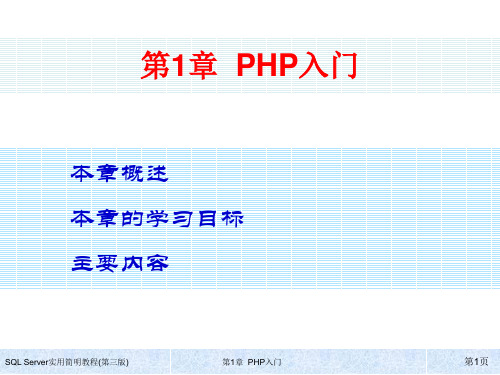
SQL Server实用简明教程(第三版)
第1章 PHP入门
第18页
1.5 调试与错误处理
使用自带的报错功能 引进调试工具 调试业务逻辑错误
SQL Server实用简明教程(第三版)
第1章 PHP入门
第19页
主要内容
1.1 Web技术基础 1.2 PHP基础知识 1.3 PHP开发环境搭建 1.4 第一个PHP程序 1.5 调试与错误处理 1.6 本章小结
第3页
主要内容
1.1 Web技术基础 1.2 PHP基础知识 1.3 PHP开发环境搭建 1.4 第一个PHP程序 1.5 调试与错误处理 1.6 本章小结
SQL Server实用简明教程(第三版)
第1章 PHP入门
第4页
1.1 Web技术基础
WWW技术。 超文本、超媒体、超文本输出协议。 B/S架构。 Web应用平台。
含了Apache、PHP、MySQL软件;在
Linux系统上,一般采用CentOS操作系统,
采用yum方式安装Apache、MySQL和
PHP组件。 SQL Server实用简明教程(第三版)
第1章 PHP入门
第15页
主要内容
1.1 Web技术基础 1.2 PHP基础知识 1.3 PHP开发环境搭建 1.4 第一个PHP程序 1.5 调试与错误处理 1.6 本章小结
SQL Server实用简明教程(第三版)
第1章 PHP入门
第16页
1.4 第一个PHP程序
<?php echo "hello world";
?>
SQL Server实用简明教程(第三版)
第1章 PHP入门
第17页
PHP和MySQLWeb应用开发
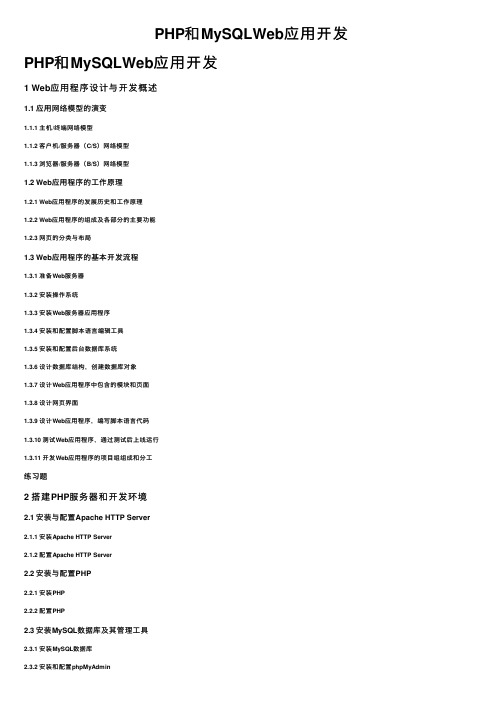
PHP和MySQLWeb应⽤开发PHP和MySQLWeb应⽤开发1 Web应⽤程序设计与开发概述1.1 应⽤⽹络模型的演变1.1.1 主机/终端⽹络模型1.1.2 客户机/服务器(C/S)⽹络模型1.1.3 浏览器/服务器(B/S)⽹络模型1.2 Web应⽤程序的⼯作原理1.2.1 Web应⽤程序的发展历史和⼯作原理1.2.2 Web应⽤程序的组成及各部分的主要功能1.2.3 ⽹页的分类与布局1.3 Web应⽤程序的基本开发流程1.3.1 准备Web服务器1.3.2 安装操作系统1.3.3 安装Web服务器应⽤程序1.3.4 安装和配置脚本语⾔编辑⼯具1.3.5 安装和配置后台数据库系统1.3.6 设计数据库结构,创建数据库对象1.3.7 设计Web应⽤程序中包含的模块和页⾯1.3.8 设计⽹页界⾯1.3.9 设计Web应⽤程序,编写脚本语⾔代码1.3.10 测试Web应⽤程序,通过测试后上线运⾏1.3.11 开发Web应⽤程序的项⽬组组成和分⼯练习题2 搭建PHP服务器和开发环境2.1 安装与配置Apache HTTP Server2.1.1 安装Apache HTTP Server2.1.2 配置Apache HTTP Server2.2 安装与配置PHP2.2.1 安装PHP2.2.2 配置PHP2.3 安装MySQL数据库及其管理⼯具2.3.1 安装MySQL数据库2.3.2 安装和配置phpMyAdmin2.4 搭建PHP开发环境2.4.1 安装Dreamweaver 82.4.2 安装EclipsePHP Studio 3练习题3 PHP语⾔基础3.1 初识PHP3.1.1 ⼀个简单的PHP程序3.1.2 PHP语⾔的基本语法3.1.3 PHP注释3.1.4 初学者的常见问题3.2 常量和变量3.2.1 数据类型3.2.2 常量3.2.3 变量3.2.4 类型转换3.3 运算符和表达式3.3.1 运算符3.3.2 表达式3.4 常⽤语句3.4.1 赋值语句3.4.2 条件分⽀语句3.4.3 循环语句3.5 字符串处理3.5.1 字符串常量3.5.2 字符串中的字符3.5.3 获取字符串的长度3.5.4 ⽐较字符串3.5.5 将字符串转换到HTML格式3.5.6 替换字符串3.5.7 URL处理函数3.6 在PHP脚本中使⽤JavaScript编程3.6.1 JavaScript脚本的使⽤3.6.2 数据类型和变量3.6.3 弹出警告对话框3.6.4 弹出确认对话框3.6.5 document对象3.6.6 弹出新窗⼝3.7 开发与调试PHP程序3.7.1 使⽤Dreamweaver设计⽹页3.7.2 创建PHP⼯程3.7.3 创建和编辑PHP⽂件3.7.4 运⾏PHP程序3.7.5 调试PHP程序练习题4 数组的使⽤4.1 数组的概念和定义4.1.1 数组的概念4.1.2 定义⼀维数组4.1.3 定义多维数组4.2 数组元素4.2.1 访问数组元素4.2.2 添加数组元素4.2.3 删除数组元素4.2.4 定位数组元素4.2.5 遍历数组元素4.2.6 确定唯⼀的数组元素4.3 常⽤数组操作4.3.1 数组排序4.3.2 填充数组4.3.3 合并数组4.3.4 拆分数组4.3.5 数组统计练习题5 接收⽤户的数据5.1 创建和编辑表单5.1.1 创建表单5.1.2 ⽂本域5.1.3 ⽂本区域5.1.4 单选按钮5.1.5 复选框5.1.6 列表/菜单5.1.7 按钮5.2 在PHP中接收和处理表单数据5.2.1 GET提交⽅式5.2.2 POST提交⽅式5.2.3 GET和POST混合提交⽅式5.2.4 使⽤JavaScript验证表单的输⼊5.3 ⽤户⾝份认证5.3.1 使⽤表单提交⽤户⾝份认证信息5.3.2 使⽤HTTP认证机制5.4 ⽂件上传5.4.1 使⽤POST⽅法上传⽂件5.4.2 配置⽂件上传练习题6 ⾃定义函数的使⽤6.1 创建和调⽤函数6.1.1 创建⾃定义函数6.1.2 调⽤函数6.1.3 变量的作⽤域6.1.4 静态变量6.1.5 变量函数6.2 参数和返回值6.2.1 在函数中传递参数6.2.2 函数的返回值6.3 函数库6.3.1 定义函数库6.3.2 引⽤函数库练习题7 PHP⾯向对象程序设计7.1 ⾯向对象程序设计思想简介7.2 定义和使⽤类7.2.1 声明类7.2.2 定义类的对象7.2.3 静态类成员7.2.4 instanceof关键字7.3 类的继承和多态7.3.1 继承7.3.2 抽象类和多态7.4 复制对象7.4.1 通过赋值复制对象7.4.2 通过函数参数复制对象练习题8 会话处理8.1 什么是会话处理8.1.1 问题的提出8.1.2 解决⽅案8.2 Cookie的应⽤8.2.1 Cookie的⼯作原理8.2.2 设置Cookie数据8.2.3 读取Cookie数据8.2.4 删除Cookie数据8.2.5 在⽤户⾝份验证时使⽤Cookie8.3 Session的应⽤8.3.1 Session的⼯作原理8.3.2 开始会话8.3.3 全局数组$_SESSION8.3.4 删除会话变量8.3.5 销毁会话8.3.6 配置Session练习题9 MySQL数据库管理9.1 数据库技术基础9.1.1 数据库的概念9.1.2 关系型数据库管理系统9.1.3 数据模型9.1.4 SQL语⾔9.2 MySQL数据库管理⼯具9.2.1 MySQL命令⾏⼯具9.2.2 图形化MySQL数据库管理⼯具phpMyAdmin 9.3 创建和维护数据库9.3.1 创建数据库9.3.2 删除数据库9.3.3 备份数据库9.3.4 恢复数据库9.4 表管理9.4.1 表的概念9.4.2 MySQL数据类型9.4.3 创建表9.4.4 编辑和查看表9.4.5 删除表9.5 管理和查询数据9.5.1 插⼊数据9.5.2 修改数据9.5.3 删除数据9.5.4 在phpMyAdmin中查询数据9.5.5 使⽤SELECT语句查询数据9.6 视图管理9.6.1 视图概述9.6.2 创建视图9.6.3 修改视图9.6.4 删除视图练习题10 在PHP中访问MySQL数据库10.1 MySQL数据库访问函数10.1.1 连接到MySQL数据库10.1.2 执⾏SQL语句10.1.3 分页显⽰结果集10.2 设计“⽹络留⾔板”实例10.2.1 系统功能分析及数据库设计10.2.2 定义数据库访问类10.2.3 设计留⾔板的主页10.2.4 显⽰主题留⾔10.2.5 添加新留⾔10.2.6 回复和删除留⾔10.3 设计“⽹络投票系统”实例10.3.1 系统功能分析及数据库设计10.3.2 设计投票项⽬管理模块10.3.3 投票界⾯设计10.4 设计“⽹站流量统计系统”实例10.4.1 系统功能分析及数据库设计10.4.2 定义数据库访问类10.4.3 设计函数库10.4.4 设计访问者界⾯10.4.5 ⽹站信息界⾯设计10.4.6 最近访问者界⾯设计10.4.7 按⽉统计界⾯设计10.4.8 按年统计界⾯设计练习题11 设计“⼆⼿交易市场系统”实例11.1 需求分析与总体设计11.1.1 系统总体设计11.1.2 数据库结构设计与实现11.2 ⽬录结构与通⽤模块11.2.1 ⽬录结构11.2.2 设计数据库访问类11.3 管理主界⾯与登录程序设计11.3.1 管理⽤户登录程序设计11.3.2 设计管理主界⾯11.3.3 设计admin\Left.php11.4 公告信息管理模块设计11.4.1 设计公告管理页⾯11.4.2 添加公告信息11.4.3 修改公告信息11.4.4 删除公告信息11.4.5 查看公告信息11.5 商品分类管理模块设计11.5.1 商品分类管理页⾯11.5.2 添加商品分类11.5.3 修改商品分类11.5.4 删除商品分类11.6 ⼆⼿商品后台管理11.6.1 商品信息管理页⾯11.6.2 删除商品信息11.7 管理员⽤户管理11.7.1 设计⽤户管理页⾯11.7.2 删除⽤户信息11.7.3 设计密码修改页⾯11.8 系统主界⾯与登录程序设计11.8.1 设计主界⾯11.8.2 设计Left.php11.8.3 注册⽤户登录程序设计11.9 商品信息管理11.9.1 分类查看商品信息11.9.2 添加商品信息11.9.3 商品图⽚上传11.9.4 查看商品信息10.9.5 查看我的商品列表11.9.6 修改商品信息11.9.7 删除商品信息11.9.8 结束商品信息11.10 个⼈⽤户管理模块设计11.10.1 注册新⽤户11.10.2 退出登录附录A 实验实验1 搭建PHP服务器⽬的和要求实验准备实验内容实验2 PHP语⾔基础⽬的和要求实验准备实验内容实验3 使⽤Dreamweaver设计⽹页⽬的和要求实验准备实验内容实验4 安装和使⽤EclipsePHP Studio ⽬的和要求实验准备实验内容实验5 使⽤数组⽬的和要求实验准备实验内容实验6 创建和编辑表单⽬的和要求实验准备实验内容实验7 使⽤⾃定义函数⽬的和要求实验准备实验内容实验8 ⾯向对象程序设计⽬的和要求实验准备实验内容实验9 会话处理⽬的和要求实验准备实验内容实验10 MySQL数据库管理⽬的和要求实验准备实验内容实验11 在PHP中访问MySQL数据库⽬的和要求实验准备实验内容⼤作业:软件资源下载系统项⽬1 系统及数据库结构设计项⽬2 ⽬录结构与通⽤模块项⽬3 设计管理员主界⾯项⽬4 后台管理模块设计项⽬5 系统主界⾯程序设计附录B HTML语⾔简介B1 基本结构标记B2 设置⽹页背景和颜⾊B3 设置字体属性B4 超级链接B5 图像和动画B6 表格B7 使⽤框架B8 层叠样式表附录C 下载本书所需的软件C1 下载Apache HTTP ServerC2 下载PHPC3 下载EclipsePHP StudioC4 下载xdebug插件C5 下载MySQL数据库C6 下载phpMyAdmin思维导图防⽌博客图床图⽚失效,防⽌图⽚源站外链:思维导图在线编辑链接:。
《Web全栈开发》-PHP MySQL
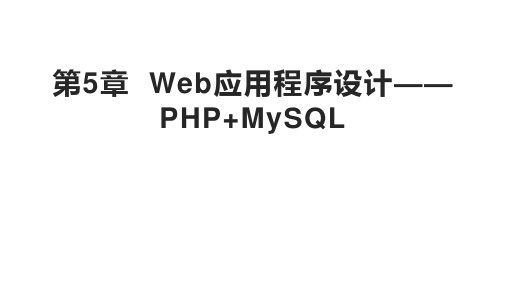
}
for语句的执行流程是:首先执行表达式1;然后判断表达式2,如 果表达式2的值为真,则执行循环体内容的语句组;最后执行表达式3 ,完成第一轮循环。
5.3 Web应用数据采集与表单操作
5.3.1 表单的概念 5.3.2 $_GET和$_POST方法 5.3.3 表单数据处理
5.3.1 表单的概念
3.响应体。响应的消息体,如请求的是纯数据返回纯数据;如请求 的是HTML页面,返回HTML代码;如请求的是JS返回JS代码。
5.1.3 HTTP基础
(1)HTTP请求行:由请求方法(GET、POST、HEAD、PUT、 DELETE、OPTIONS、TRACE、CONNECT)、URL和协议版本3个字 段组成,用空格分隔。 (2)请求报头信息:为请求报文添加了一些附加信息,由键值对组成, 每行一对,键和值之间使用冒号分隔。 (3)空行:用于区分请求报头信息和请求正文。 (4)请求正文:请求正文在HTTP请求中是一个可选部分。 (5)响应报文:服务器收到客户端请求之后,对客户端做出的回复。
5.2.4 内置变量
PHP程序是运行在服务器端的,PHP解释器运行的时候有很多的 服务器端环境被预设为内置的变量。这些变量是PHP在脚本运行时自 动创建的,如$_SERVER变量中存储了许多PHP运行的计算机环境相 关信息。
5.2.5 字符串
字符串是包含在一对单引号“'”或双引号“"”中的任意数量的字符 。字符串可以包含任何字符组合:字母、数字、符号和空格。
PHP操作数据库的流程:PHP将操作数据库的SQL语句发送给数 据库应用程序,数据库应用程序执行这些操作语句,然后将执行的结 果(创建表、插入记录、检索某些记录,甚至错误)返回给PHP程序 。
- 1、下载文档前请自行甄别文档内容的完整性,平台不提供额外的编辑、内容补充、找答案等附加服务。
- 2、"仅部分预览"的文档,不可在线预览部分如存在完整性等问题,可反馈申请退款(可完整预览的文档不适用该条件!)。
- 3、如文档侵犯您的权益,请联系客服反馈,我们会尽快为您处理(人工客服工作时间:9:00-18:30)。
3.10.3 统计数组元素个数:count()、sizeof()和array_count_values() 73
3.10.4 将数组转换成标量变量:extract() 73
3.11 进一步学习 75
4.6 正则表达式的介绍 88
4.6.1 基础知识 88
4.6.2 字符集和类 88
4.6.3 重复 89
4.6.4 子表达式 89
4.6.5 子表达式计数 90
4.6.6 定位到字符串的开始或末尾 90
4.6.7 分支 90
下载地址:/image/php.rar
我的空间有限啊
希望版主能补传啊 我果断时间就要删掉了哦 呵呵
抓紧时间 下载吧
别抢沙发啊 留着备用啊
下载地址在2楼啊 有钱的给点钱啊 呵呵 穷!
作者:Luke Welling 编著
4.2.3 格式化字符串以便存储:addslashes()和stripslashes() 81
4.3 用字符串函数连接和分割字符串 82
4.3.1 使用函数explode()、implode()和join() 82
4.3.2 使用strtok()函数 83
1.3 在HTML中嵌入PHP 4
1.3.1 使用PHP标记 5
1.3.2 PHP标记风格 5
1.3.3 PHP语句 6
1.3.4 空格 6
1.3.5 注释 7
1.4 添加动态内容 8
1.4.1 调用函数 8
5.11 从函数返回一个值 111
5.12 实现递归 113
5.13 进一步学习 114
5.14 下一章 114
第6章 面向对象的PHP 115
1.4.2 使用date()函数 9
1.5 访问表单变量 9
1.5.1 表单变量 9
1.5.2 字符串的连接 11
1.5.3 变量和文本 12
1.6 理解标识符 13
1.7 创建用户声明的变量 13
1.8 给变量赋值 13
1.14 理解操作符的优先级和结合性:表达式求值 24
1.15 使用可变函数 25
1.15.1 测试和设置变量类型 26
1.15.2 测试变量状态 26
1.15.3 变量的重解释 27
1.16 实现控制结构 27
1.17 根据条件进行判断 27
3.12 下一章 75
第4章 字符串操作与正则表达式 76
4.1 创建一个示例应用程序:智能表单邮件 76
4.2 字符串的格式化 78
4.2.1 字符串的整理:chop()、ltrim()和trim() 78
4.2.2 格式化字符串以便显示 78
5.2.1 require()函数 95
5.2.2 文件扩展名和require()语句 96
5.2.3 PHP标记和require()语句 96
5.3 使用require()制作Web站点的模版 96
5.3.1 使用include() 100
4.3.3 使用substr()函数 83
4.4 字符串的比较 84
4.4.1 字符串的排序:strcmp()、strcasecmp()和strnatcmp() 84
4.4.2 使用strlen()函数测试字符串的长度 85
4.5 使用字符串函数匹配和替换子字符串 85
1.9 检查变量的类型 13
1.9.1 PHP的数据类型 13
1.9.2 类型强度 14
1.9.3 类型转换 14
1.9.4 可变变量 14
1.10 声明和使用常量 15
1.11 理解变量的作用域 16
1.12 使用操作符 16
4.5.1 在字符串中查找字符串:strstr()、strchr()、strrchr()和stristr() 85
4.5.2 查找子字符串的位置:strpos()、strrpos() 86
4.5.3 替换子字符串:str_replace()、substr_replace() 87
1.22 下一章:保存客户的订单 37
第2章 数据的存储与检索 38
2.1 保存数据以便后期使用 38
2.2 存储和检索Bob的订单 38
2.3 文件处理 39
2.4 打开文件 40
2.4.1 选择文件模式 40
2.4.2 使用fopen()打开文件 40
3.8.2 使用array-reverse()函数 68
3.9 从文件载入数组 69
3.10 执行其他的数组操作 71
3.10.1 在数组中浏览:each()、current()、reset()、end()、next()、pos()和prev() 71
读者反馈
译者序
前言
关于作者
致谢
第一篇 使用PHP
第1章 PHP快速入门教程 1
1.1 使用PHP 2
1.2 创建一个示例应用:Bob誷 Auto Parts(Bob汽车零部件商店) 2
1.2.1 创建订单表单 2
1.2.2 表单处理 4
2.4.3 通过FTP或HTTP打开文件 42
2.4.4 解决打开文件时可能遇到的问题 42
2.5 写文件 44
2.5.1 fwrite()的参数 44
2.5.2 文件格式 45
2.6 关闭文件 45
2.7 读文件 47
3.6.2 使用asort()函数和ksort()函数对相关数组排序 64
3.6.3 反向排序 65
3.7 多维数组的排序 65
3.7.1 用户定义排序 65
3.7.2 反向用户排序 66
3.8 对数组进行重新排序 67
3.8.1 使用shuffle()函数 67
5.3.2 使用require_once()和include_once() 100
5.3.3 使用auto_prepend_file和auto_append_file 101
5.4 在PHP中使用函数 101
5.4.1 调用函数 101
5.4.2 调用未定义的函数 103
1.12.1 算术操作符 17
1.12.2 字符串操作符 17
1.12.3 赋值操作符 17
1.12.4 比较操作符 19
1.12.5 逻辑操作符 20
1.12.6 位操作符 21
1.12.7 其他操作符 21
1.13 使用操作符:计算表单总金额 23
2.8.3 删除一个文件:unlink() 51
2.8.4 在文件中定位:rewind()、fseek()和ftell() 52
2.9 文件锁定 52
2.10 更好的方式:数据库管理系统 53
2.10.1 使用普通文件的几个问题 54
2.10.2 RDBMS是如何解决这些问题的 54
2.7.1 以只读模式打开文件:fopen() 48
2.7.2 知道何时读完文件:feof() 48
2.7.3 每次读取一行数据:fgets()、fgetss()和fgetcsv() 49
2.7.4 读取整个文件:readfile()、fpassthru()和file() 49
1.18.1 while循环 33
1.18.2 for和foreach循环 34
1.18.3 do...while循环 35
1.19 从控制结构或脚本中跳出 35
1.20 使用可替换的控制结构语法 36
1.21 使用declare 36
4.6.8 匹配特殊字符 90
4.6.9 特殊字符一览 91
4.6.10 在智能表单中应用 91
4.7 用正则表达式查找子字符串 92
4.8 用正则表达式替换子字符串 93
4.9 使用正则表达式分割字符串 93
4.10 比较字符串函数和正则表达式函数 93
3.3 使用不同索引的数组 59
3.3.1 初始化相关数组 59
3.3.2 访问数组元素 59
3.3.3 使用循环语句 59
3.4 数组操作符 60
3.5 多维数组 61
3.6 数组排序 64
3.6.1 使用sort()函数 64
2.11 进一步学习 54
2.12 下一章 55
第3章 使用数组 56
3.1 什么是数组 56
3.2 数字索引数组 57
3.2.1 数字索引数组的初始化 57
3.2.2 访问数组的内容 57
3.2.3 使用循环访问数组 58
出版社:机械工业出版社
出版时间:2005年6月
面数:666
书店价:78.00
本书将PHP开发与MySQL应用相结合,分别对PHP和MySQL做了深入浅出的分析,不仅介绍PHP和MySQL的一般概念,而且对PHP和MySQL的Web应用做了较全面的阐述,并包括几个经典且实用的例子。
本书是第3版,经过了全面的更新、重写以及扩展,包括PHP5的最新特性——新的对象模型、更好的异常处理和SimpleXML;以及MySQL 5的新特性,例如存储过程和存储引擎。
5.4.3 理解字母大小写和函数名称 103 Байду номын сангаас
5.5 理解为什么要定义自己的函数 103
5.6 了解基本的函数结构 104
5.7 使用参数 105
5.8 理解作用域 107
